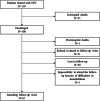Six-month respiratory outcomes and exercise capacity of COVID-19 acute respiratory failure patients treated with continuous positive airway pressure
- PMID: 33961728
- PMCID: PMC8242499
- DOI: 10.1111/imj.15345
Six-month respiratory outcomes and exercise capacity of COVID-19 acute respiratory failure patients treated with continuous positive airway pressure
Abstract
Background: COVID-19 long-term sequelae are ill-defined since only a few studies have explored the long-term consequences of this disease so far.
Aims: To evaluate the 6-month respiratory outcome and exercise capacity of COVID-19 acute respiratory failure (ARF) patients treated with continuous positive airway pressure (CPAP) during the first wave of the ongoing COVID-19 pandemic.
Methods: A retrospective observational study included COVID-19 patients with ARF. Interventions included CPAP during hospitalisation and 6-month follow up. Frailty assessment was carried out through frailty index (FI), pO2 /FiO2 during hospitalisation and at follow up, respiratory parameters, 6-min walking test (6MWT) and the modified British Medical Research Council (mMRC) and Borg scale at follow up.
Results: More than half of the patients had no dyspnoea according to the mMRC scale. Lower in-hospital pO2 /FiO2 correlated with higher Borg scale levels after 6MWT (ρ 0.27; P 0.04) at the follow-up visit. FI was positively correlated with length of hospitalisation (ρ 0.3; P 0.03) and negatively with the 6MWT distance walked (ρ -0.36; P 0.004).
Conclusions: Robust and frail patients with COVID-19 ARF treated with CPAP outside the intensive care unit setting had good respiratory parameters and exercise capacity at 6-month follow up, although more severe patients had slightly poorer respiratory performance compared with patients with higher PaO2 /FiO2 and lower FI.
Keywords: COVID-19; acute respiratory failure; exercise capacity; follow up.
© 2021 Royal Australasian College of Physicians.
Figures
Comment on
-
6-month consequences of COVID-19 in patients discharged from hospital: a cohort study.Lancet. 2021 Jan 16;397(10270):220-232. doi: 10.1016/S0140-6736(20)32656-8. Epub 2021 Jan 8. Lancet. 2021. Retracted and republished in: Lancet. 2023 Jun 17;401(10393):2025. doi: 10.1016/S0140-6736(23)01175-3. PMID: 33428867 Free PMC article. Retracted and republished.
References
Publication types
MeSH terms
LinkOut - more resources
Full Text Sources
Other Literature Sources
Medical



